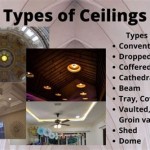Why Do New Builds Have Low Ceilings?
When looking for a new home, one of the things you may notice is that many new builds have lower ceilings than older homes. There are several reasons for this, including energy efficiency, cost-effectiveness, and design trends.
Energy Efficiency
One of the main reasons for lower ceilings in new builds is energy efficiency. A home with lower ceilings will require less energy to heat and cool. This is because there is less space to heat or cool, and the heat or cool air will not have to travel as far to reach the desired temperature.
Cost-Effectiveness
Another reason for lower ceilings in new builds is cost-effectiveness. Lower ceilings mean that less materials are needed to build the home. This can save the builder money, which can then be passed on to the buyer.
Design Trends
In addition to energy efficiency and cost-effectiveness, lower ceilings are also a popular design trend. Lower ceilings can make a room feel more cozy and intimate. They can also help to create a more modern look.
Other Factors
In addition to the reasons listed above, there are a few other factors that can contribute to lower ceilings in new builds. These factors include:
- The type of home being built. Single-family homes typically have lower ceilings than multi-family homes.
- The location of the home. Homes in colder climates tend to have lower ceilings than homes in warmer climates.
- The age of the home. Older homes tend to have higher ceilings than newer homes.
Is There a Downside to Lower Ceilings?
While there are many benefits to lower ceilings, there are also a few downsides to consider. These downsides include:
- Lower ceilings can make a room feel smaller and more cramped.
- Lower ceilings can be difficult for tall people to live in.
- Lower ceilings can make it difficult to install certain types of lighting and furniture.
Overall, the decision of whether or not to buy a home with lower ceilings is a personal one. There are both benefits and drawbacks to consider, and each buyer will need to weigh the factors that are most important to them.
Why Do They Make Low Ceiling Houses Quora
Making The Most Of Low Ceiling Spaces Mansion Global

Ceilings Literal That Are Too Low Sacramento Appraisal Blog

What Is The Average And Minimum Ceiling Height In A House Design For Me

Basements With Low Ceilings Remodeling Ideas For

Make Ceilings Look Taller Here S How The Interiors Addict

Basement Remodeling For Low Ceilings Gamco

10 Ways To Make Living Room Ceilings Look Higher Homes Gardens

Loft Conversion Tips How To Get Over The Issue Of A Low Ceiling Bespoke Lofts

I Inspect New Build Houses And There S Some From Loos Wouldn T Use Wobbly Ceilings To Dangerous Lofts The Us Sun
Related Posts








